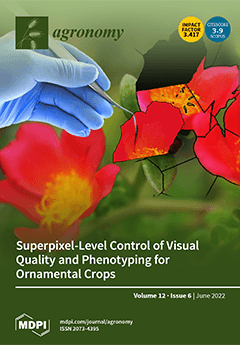The depletion of soil organic matter is one of the major challenges constraining agricultural production in the southern zone of Mali. This study evaluated the effects of compost types, methods, and dose applications on the productivity and sustainability of sorghum. Two types of compost (farmer practice and cotton stems) were applied to sorghum at two rates (microdosing at 2.5 t ha
−1 and broadcasting at 5 t ha
−1) and evaluated on 30 farmer fields in 2019 and 2020. The treatments used included CPA (cotton stem compost at 5 t ha
−1 + 100 kg ha
−1 DAP), CPA (cotton stem compost at 2.5 t ha
−1 + 100 kg ha
−1 DAP), CP (farmer compost at 5 t ha
−1 + 100 kg ha
−1 DAP), CP (famer compost at 2.5 t ha
−1 + 100 kg ha
−1 DAP), control (100 kg ha
−1 DAP), and control. The results showed that regardless of the compost type, applying a microdose of 2.5 t ha
−1 improved the growth rate, plant height, grain yield, and biomass yield by 15%, 18%, 47%, and 27%, respectively, when compared to the control. No statistical difference was observed in the yield of 2061 kg ha
−1 between applying compost by microdosing at 2.5 t ha
−1 and broadcasting at 5 t ha
−1. It can be inferred that the application of compost by microdosing makes it possible to achieve a 100% fertilized surface compared to broadcasting, with a nitrogen use efficiency of more than 55%. The application of compost by microdosing at 2.5 t ha
−1 resulted in an economic gain of 334,800 XOF ha
−1, which was 27% higher than that obtained with the application of compost by broadcasting at 5 t ha
−1. Conversely, the contribution to the improvement of soil nitrogen stock varied from 12–20% with a microdose of 2.5 t ha
−1 compared to 100% for broadcasting compost at 5 t ha
−1 per application. Therefore, the availability of cotton stems in the southern zone of Mali presents an opportunity for farmers to implement compost microdose technology to double the fertilized area and improve sorghum productivity.
Full article





